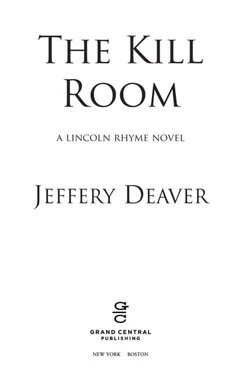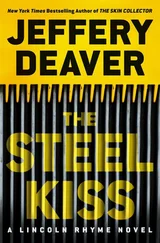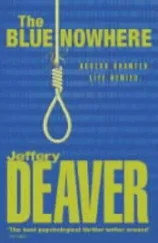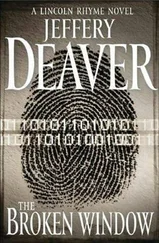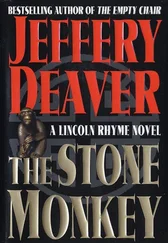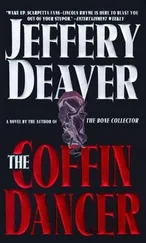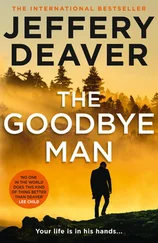However, the next pages on the iPad, photos of the Kill Room itself, were illuminating. Moreno had been shot in the living room of the suite. Everything and everyone in the room was covered with shards of glass. Moreno lay sprawled on a couch, head back, mouth open, a bloodstain on his shirt, in the center of which was a large black dot, the entrance wound. The upholstery behind him was covered in dark blood and gore, from what would have been a massive exit wound caused by the sniper’s bullet.
The other victims lay on their backs near the couch, one a large Latino, identified in the photo as Simon Flores, Moreno’s guard, the other a dapper bearded balding man in his fifties, de la Rua, the reporter. They were covered with broken glass and blood, their skin torn and slashed in dozens of places.
The bullet itself was photographed lying on the floor next to a small sandwich board evidence location card bearing the number 14. It was lodged in the carpet a few feet behind the couch.
Rhyme flipped the page, expecting to see more.
But the next image was of the corporal with his wife again, sitting in beach chairs.
Without looking his way, Poitier said, “That’s all there is.”
“Not the autopsy?”
“One has been done. We don’t have the results.”
Rhyme asked, “The victims’ clothing?”
Now he regarded the criminalist. “At the morgue.”
“I asked my associate at the South Cove to track down de la Rua’s camera, tape recorder and anything else he had with him. He said they went to the morgue. I’d love to see them.”
Poitier gave a skeptical laugh. “I would have too.”
“Would have ?”
“Yes, you caught that, Captain. By the time I inquired about them they were missing, along with the victims’ more valuable personal effects.”
Rhyme had noticed in the picture of the bodies that the guard wore a Rolex watch, and a pair of Oakley sunglasses protruded from his pocket. Near the reporter lay a gold pen.
Poitier added, “Apparently you must be fast here securing evidence when you run a scene. I’m learning that. The lawyer I was mentioning?”
“The prominent lawyer.”
“Yes,” Poitier said. “After he was killed and before our detectives got there, half the office was looted.”
Rhyme said, “You have the bullet, though.”
“Yes. In our evidence locker. But that meeting with Assistant Commissioner McPherson after you left headquarters? It was to order me to deliver to him all the evidence in the Moreno case. He has taken custody and sealed the locker. No one else can have access. Oh, he also ordered me to have no contact whatsoever with you.”
Rhyme sighed. “They really don’t want this case to go forward, do they?”
With a bitterness Rhyme had not heard before, he said, “Ah, but the case has gone forward. Indeed, it is concluded. The cartels have murdered the victim out of retribution for one thing or another. Who can tell, with those inscrutable cartels?” The man grimaced. Then his voice lowered. “Now, Captain Rhyme, I couldn’t get you your physical evidence, as I’d hoped. But I can play tour guide.”
“Tour guide?”
“Indeed. We have a wonderful tourist attraction on the southwest coast of New Providence Island. A spit of land a half mile long, ravaged by hurricanes, composed mostly of rock and beaches with tainted sand. The highlights are a trash tip, a metal fabrication plant cited frequently for polluting and a company that shreds tires for recycling.”
“Sounds charming,” Thom said.
“It’s quite popular. At least it was for one American tourist. He visited it on the ninth of May. At around eleven fifteen in the morning. One of the more attractive sights he enjoyed was of the South Cove Inn. An unobstructed view, exactly two thousand one hundred and ten yards away. I thought that you, as a tourist to our country, might enjoy the sights as well. Am I right?”
“You are indeed, Corporal.”
“Then we should go. I will not have a career as a tour guide for much longer.”
CHAPTER 38
AS SHE SPED DOWNTOWN, Amelia Sachs disconnected the call from Rodney Szarnek, with the Computer Crimes Unit. She’d used a prepaid mobile—paid for out of her own pocket, with cash, of course—and was confident that the conversation hadn’t been intercepted by the man they were now in the process of tracking down.
Szarnek had told her that the NIOS sniper was presently having a conversation near the Wall Street area of the city while on foot.
The cybercrimes cop had given Sachs the general location of the man and she was speeding there now. When she arrived she’d call back and Rodney’d try to pinpoint the exact coordinates.
She slammed the clutch of her Torino Cobra to the floor and downshifted hard, rev-matched and then sped up, leaving a twin-stripe signature in rubber on the concrete.
She wove through traffic until a jam loomed. “Come on, come on.” She detoured onto a crosstown street east, skidding into what would have been a U-turn, except to avoid a sudden jaywalker she had to make it a Q. She tried again and was soon bolting through side streets, making her way east and south, toward downtown.
“Hell,” Sachs muttered, faced with another jam, and decided to conscript the closest cross street, which was more or less clear, though it happened to be one-way, against her. The maneuver threw drivers into panic and raised a symphony of off-pitch horns. Some single fingers too. Then she zipped past a yellow cab just before the driver sought the sidewalk and she was on Broadway, heading south. She paused for most of the red lights.
There’s a lot of controversy about cell phone companies’ giving law officers details about phone use and location. Generally in an emergency, the providers will cooperate without a warrant. Otherwise, most will require a court order. Rodney Szarnek didn’t want to take any chances and so after learning the sniper’s number from Pulaski in the Bahamas he’d contacted a magistrate and gotten paper issued—both for a five-second listen-in, to snag the voiceprint, and to track the location.
Szarnek had learned that the phone was in use around the corner of Broadway and Warren Street, using basic triangulation for that information, which gave rough estimates. He was presently working on interpolating signal data from the nearby network antennas. Searching in urban areas was much easier because many more towers were erected there than in rural areas. The downside, of course, was that there were many more users in any given area of a city, so it was harder to isolate your particular suspect than, say, in farmland.
Szarnek was hoping to nail down GPS data, which was the gold standard of tracking and would give the location of the sniper to within a few feet.
Finally Sachs arrived in the general vicinity, took a turn at forty, missing both a bus and a hot dog stand by inches, and skidded to a stop on a side street off Broadway. The aroma of baking tires rose, a smell nostalgic and comforting.
She looked around at the hundreds of passersby, about 10 percent of them on their phones. Was the shooter one of the people she was peering at right now? The lean young man with the crew cut, wearing khaki slacks and a work shirt? He looked military. Or the sullen, dark-complected man who was in a badly fitting suit and looking around suspiciously from behind darkly tinted sunglasses? He looked like a hit man but might have been an accountant.
How long would Bruns stay on the line? she wondered. If he disconnected they could still follow him, unless he pulled the battery out. But it was easier to spot someone actually using a phone.
She reminded herself too: This could be a trap. She recalled all too clearly the explosion at Java Hut. The sniper knew about the investigation. He clearly knew about her; Sachs’s phone was the one he’d tapped to learn about the coffee shop. A trickle of electric fear down her spine once more.
Читать дальше
